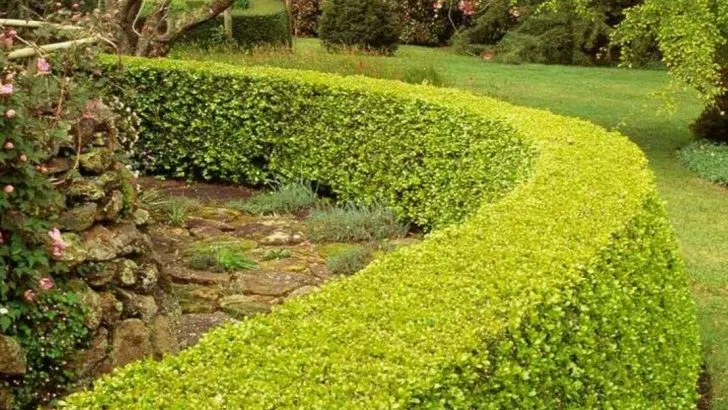A garden that stays lush and vibrant throughout the seasons is a dream for many gardeners. These 23 evergreen plants provide year-round beauty, adding structure, color, and life to your outdoor space no matter the weather.
Boxwood
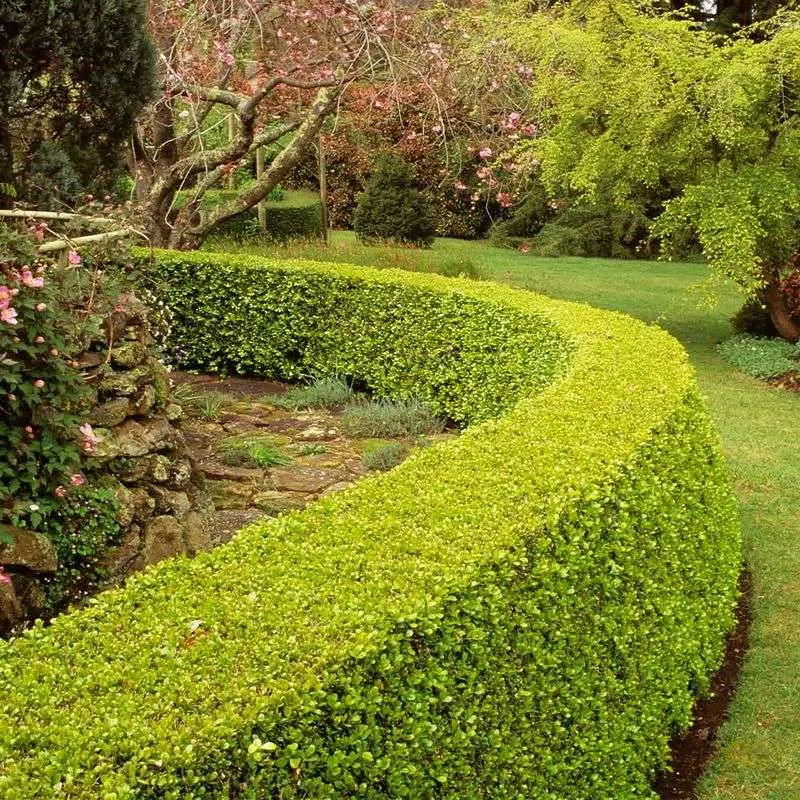
Known for its dense, verdant foliage, boxwood stands as a reliable garden staple. Its versatility allows it to be shaped into various forms, from simple hedges to intricate topiaries. This plant thrives in both sun and partial shade, making it adaptable to various garden settings. Additionally, boxwoods are relatively low-maintenance, requiring only regular watering and occasional pruning. With its evergreen nature, it brings constant color and structure to any landscape. Consider placing it along pathways or as a garden border to create a sophisticated look that lasts throughout the year.
Holly
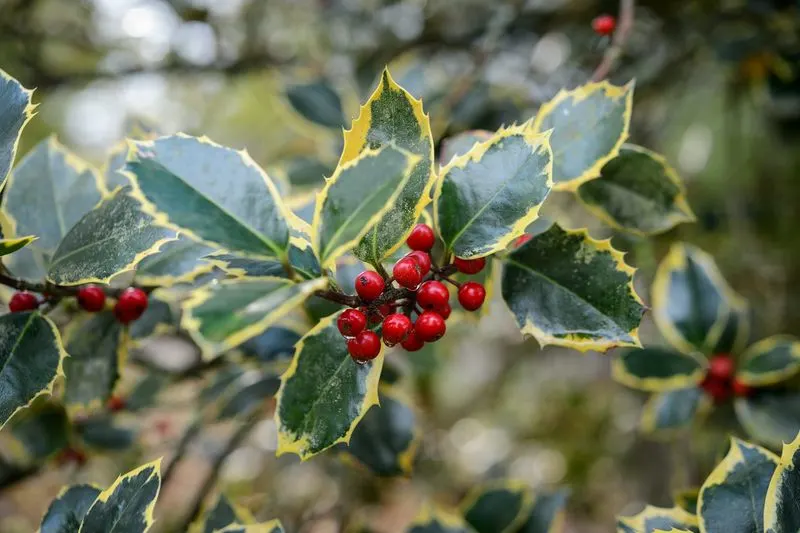
While many recognize holly for its festive associations, its year-round beauty is undeniable. Glossy green leaves paired with vibrant red berries make it a standout choice for gardeners. Holly can act as a focal point in garden beds or as a lively hedge. This plant is not only a visual treat but also attracts birds, adding another layer of life to your space. Hardy and resilient, holly requires minimal maintenance apart from occasional trimming. Its ability to withstand various climates makes it an excellent addition for those seeking enduring garden interest.
Juniper
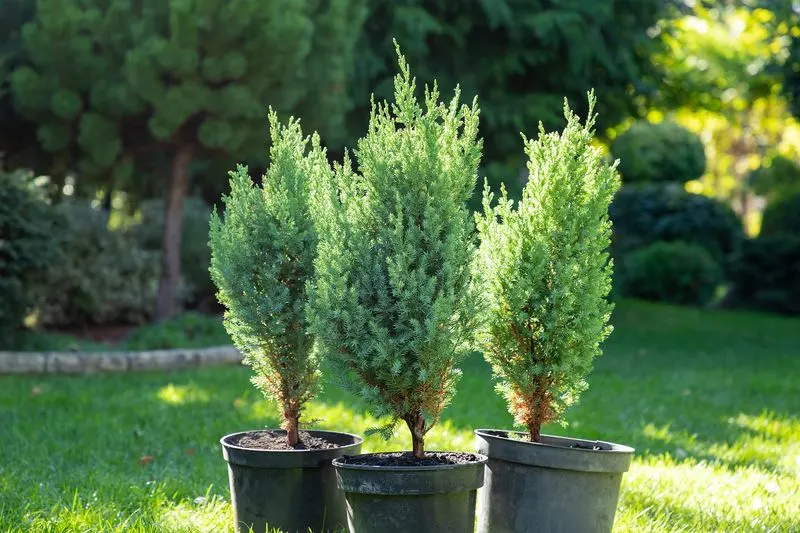
Junipers are a diverse group of evergreens with species that suit almost any garden environment. Their rugged beauty is complemented by their adaptability, from ground covers to towering trees. A notable feature is their aromatic foliage, which releases a fresh scent when brushed against. Junipers thrive in sunny locations, and their drought-tolerant nature makes them a practical choice for less attentive gardeners. These evergreens also provide shelter for wildlife, enhancing the biodiversity of your garden. With minimal care needs, junipers offer a reliable green presence year-round.
Lavender
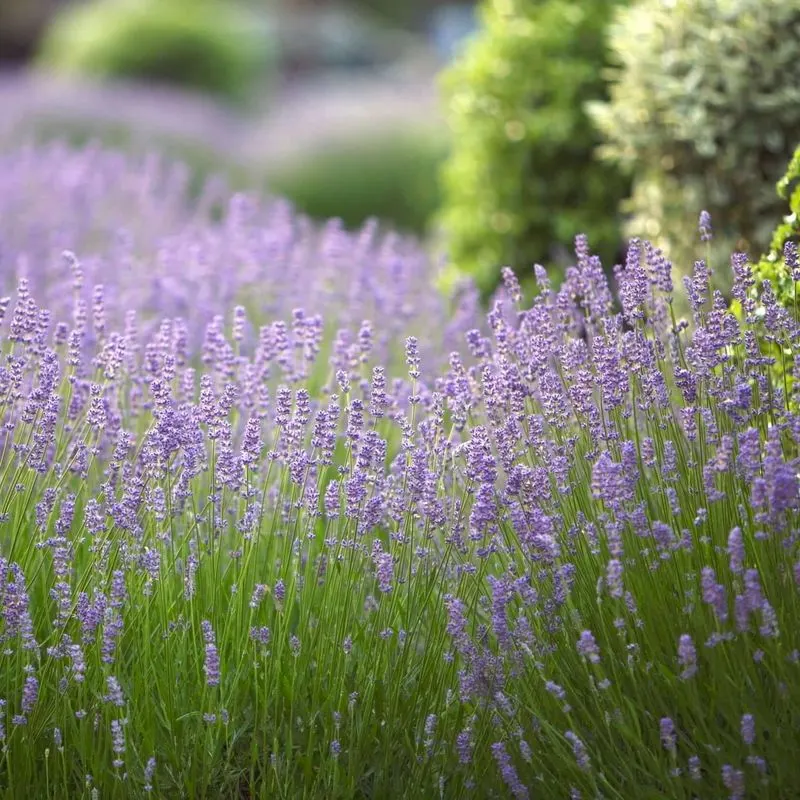
Lavender brings a touch of elegance with its silvery-green leaves and fragrant blooms. Though often associated with its vibrant flowers, even out of bloom, its foliage remains a stunning feature. Lavender prefers sunny spots and well-drained soil, making it ideal for rock gardens or borders. Its aromatic leaves can be dried for use in sachets or potpourri, adding value beyond visual appeal. Regular pruning encourages denser growth and maintains its shape. Whether lining pathways or filling planters, lavender’s evergreen nature ensures continuous garden charm.
Pine
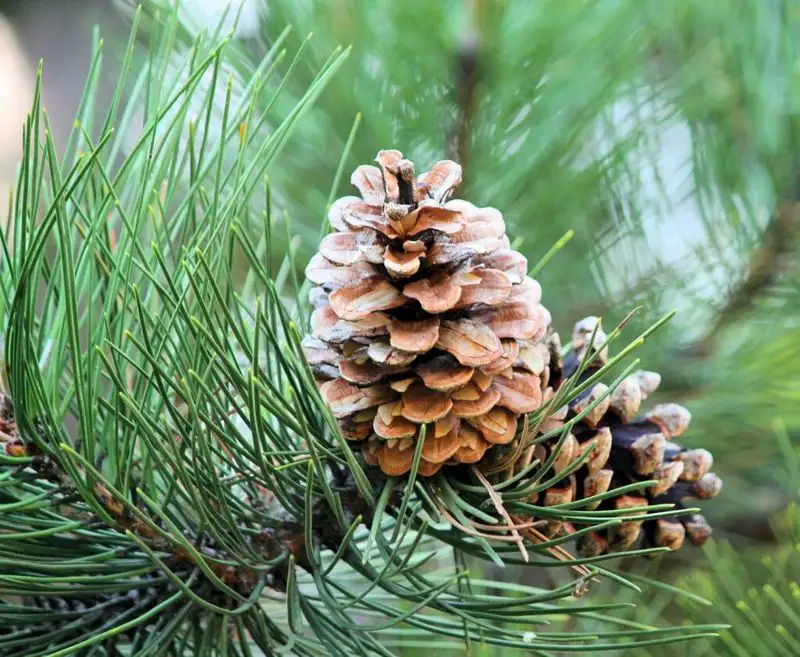
Pine trees bring a towering presence and classic beauty to gardens. Their needle-like foliage stays vibrant throughout the seasons, providing constant greenery. Pines are excellent for creating windbreaks or serving as focal points in larger landscapes. They prefer sunny locations and well-drained soil but are otherwise undemanding. Beyond aesthetics, pine needles can be used as mulch, offering practical benefits. These trees also provide habitat and food for wildlife, adding ecological value. With their enduring appeal and functionality, pines remain a cherished choice for gardeners.
Rhododendron
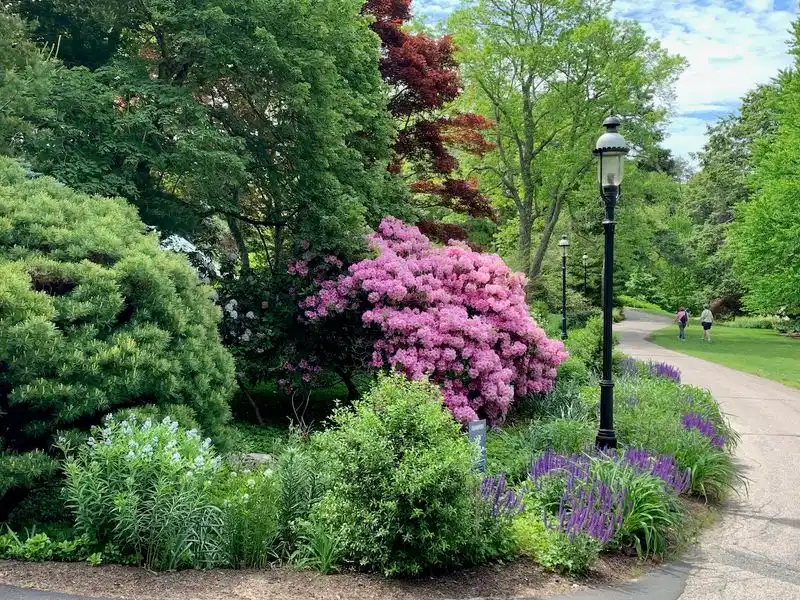
Rhododendrons offer captivating beauty with their vibrant blooms and sturdy evergreen leaves. While their flowers steal the show in spring, their foliage remains a delight throughout the year. These plants thrive in shaded areas with acidic soil, making them suitable for woodland gardens. Regular watering and mulching help maintain their health and vibrancy. Rhododendrons can be planted as standalone specimens or grouped together for a more dramatic effect. Their lush presence provides a year-round visual treat, ensuring your garden remains inviting even in the off-season.
Spruce
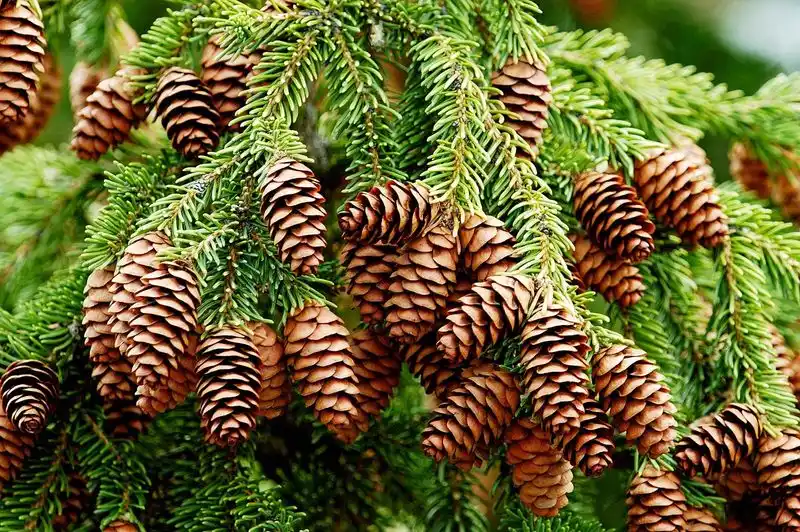
Spruce trees are often treasured for their symmetrical shape and robust nature. Their dense needles provide rich, deep green color, making them a popular choice for ornamentals and windbreaks. Spruces adapt well to various soil types and climates, thriving best in full sun. Minimal pruning is required, as their natural form is inherently pleasing. In addition to aesthetic value, they offer shelter for birds and other wildlife. Whether as standalone specimens or in groups, spruces bring enduring beauty and ecological benefits to gardens.
Cypress
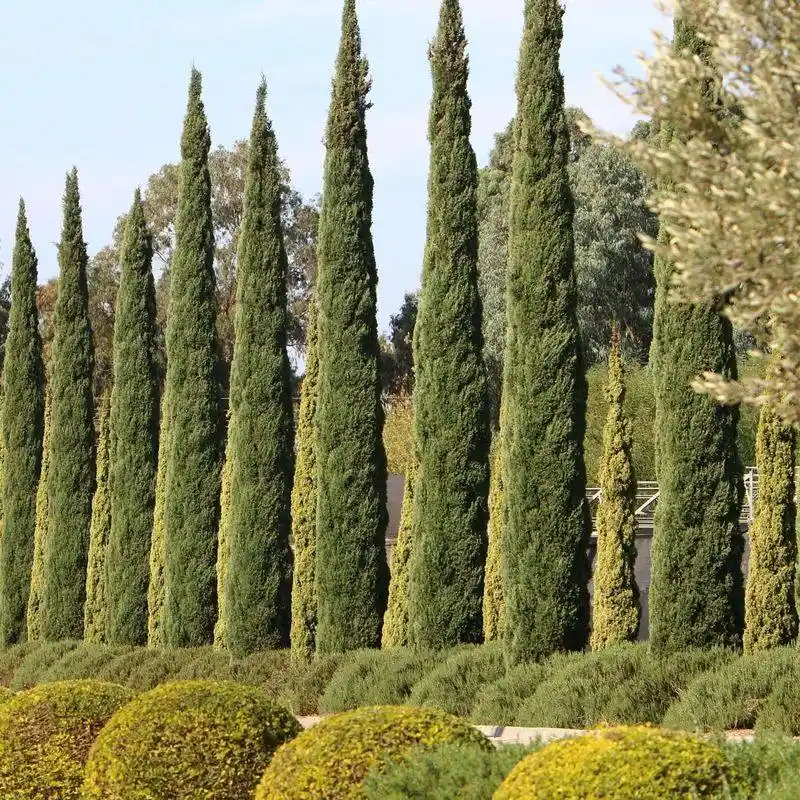
Cypress trees exude elegance with their slender form and feathery foliage. Perfect for privacy screens or lining driveways, they add a sense of order and grandeur to landscapes. Cypress trees are drought-tolerant once established, requiring minimal care. Their adaptability to different soils, coupled with a fast growth rate, makes them an attractive choice for impatient gardeners. They also play a role in supporting wildlife, offering shelter and nesting sites. With their distinct shape and reliable greenery, cypresses enhance the structural beauty of outdoor spaces.
Mugo Pine
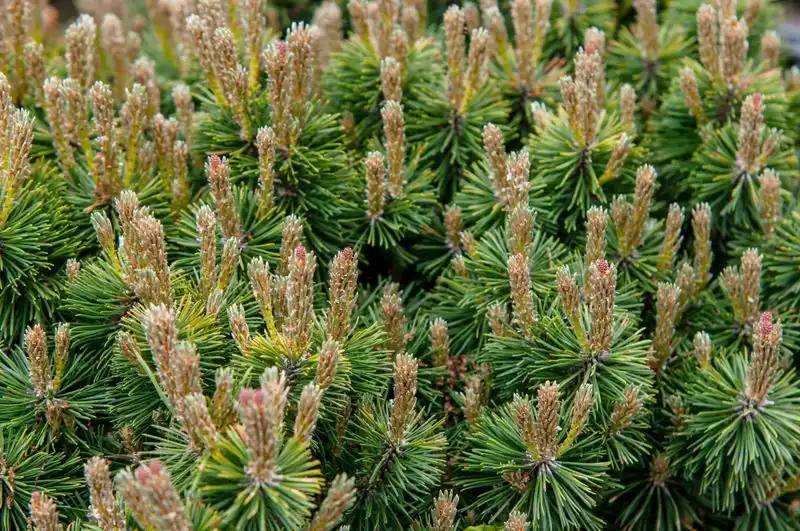
Mugo pines are valued for their compact size and rugged, alpine appearance. Their dense needles add texture and color to gardens, thriving in sunny, well-drained locations. These pines are perfect for rock gardens or as part of mixed borders. Mugo pines require little maintenance, needing only occasional pruning to maintain shape. Their hardy nature makes them suitable for challenging environments where other plants may struggle. With their year-round greenery and resilience, mugo pines are an excellent choice for adding structure and interest to smaller gardens.
Daphne
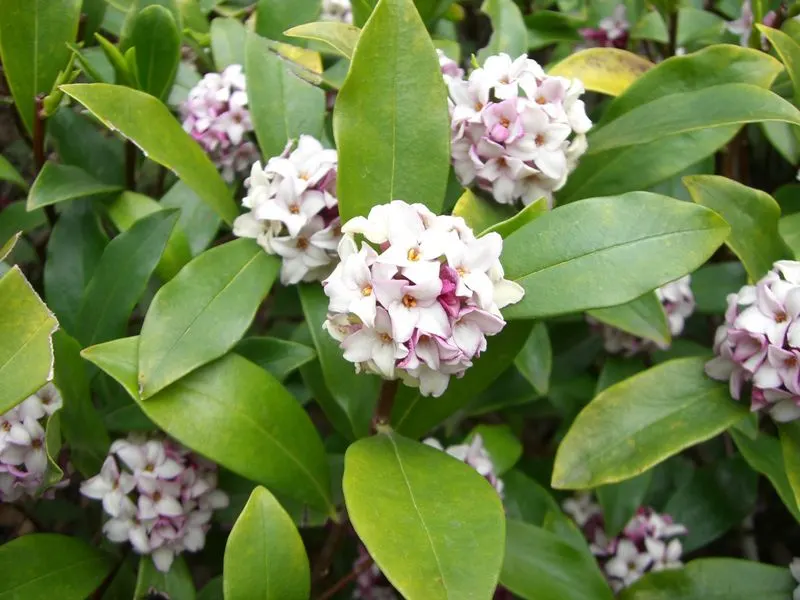
Daphne plants are renowned for their fragrant flowers and lush foliage. Their evergreen leaves offer continuous color, while their blooms provide seasonal interest. These plants prefer partial shade and well-drained soil, requiring careful placement. Though delicate in appearance, daphnes are hardy and resilient once established. Minimal pruning is needed to maintain their shape, making them relatively low-maintenance. Daphne’s scent is an added bonus, offering a sensory delight as you navigate the garden. With their combination of fragrance and beauty, they make a charming addition to any garden.
Camellia
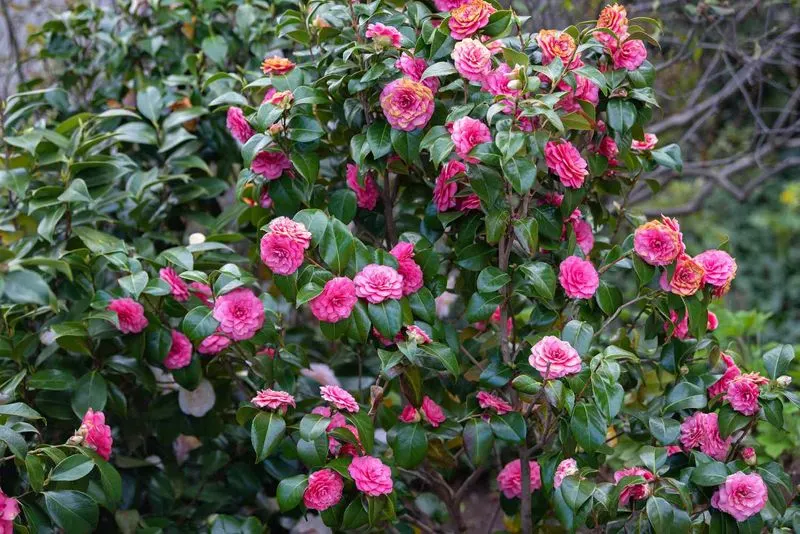
Camellias bring elegance with their glossy leaves and showy flowers. While their blooms are the highlight, the foliage remains attractive year-round. These plants thrive in partial shade with acidic, well-drained soil. Regular watering and mulching enhance their growth, while minimal pruning keeps them tidy. Camellias can serve as stunning standalone specimens or be part of a mixed border. Their flowers, available in a range of colors, add seasonal color bursts. With their enduring leaves and captivating blooms, camellias ensure that gardens remain visually appealing throughout the year.
Bay Laurel
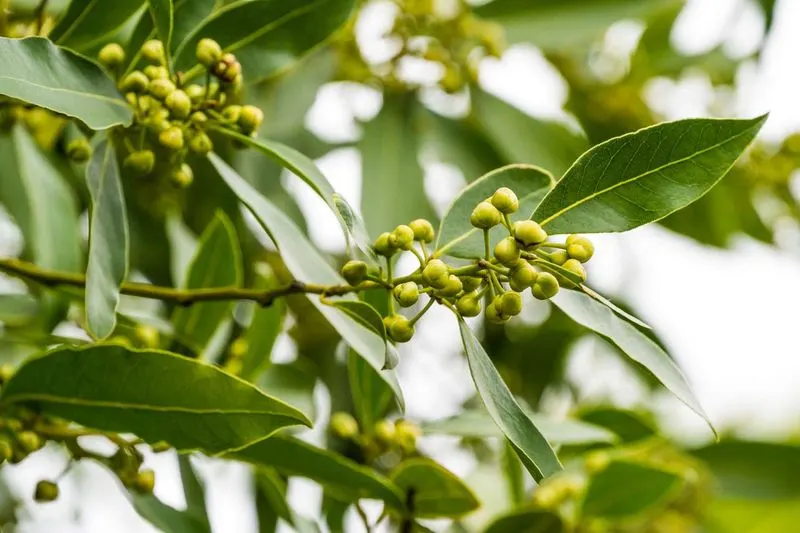
Bay laurel offers beauty and utility, with aromatic leaves often used in culinary creations. Its dark green foliage remains vibrant year-round, adding constant visual interest. This plant thrives in sunny locations with well-drained soil, and regular pruning encourages denser growth. Bay laurels can be grown in containers or as part of a herb garden, providing both greenery and flavor. Their leaves can be harvested for cooking, enhancing dishes with a rich aroma. With its practical uses and evergreen nature, bay laurel is a delightful addition to any garden.
Heather
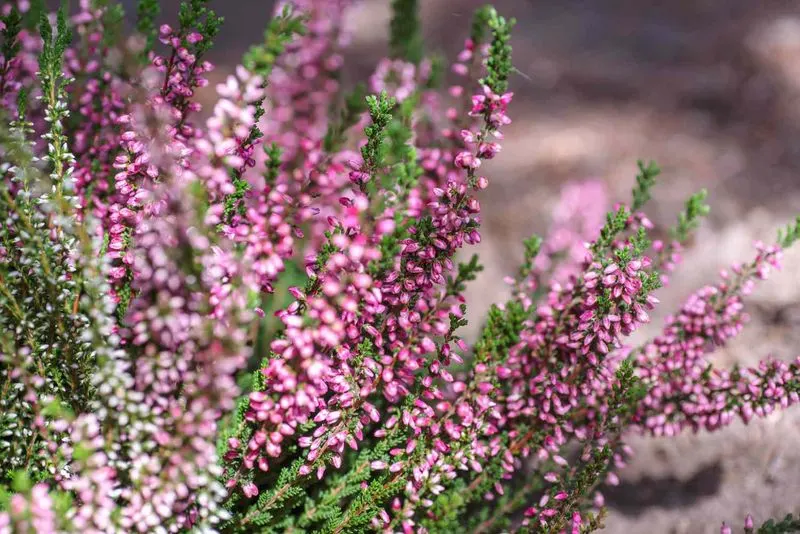
Heather plants offer a tapestry of color, with flowers in shades of purple, pink, and white. Even when not in bloom, their foliage provides texture and interest. Heather thrives in sunny locations with well-drained, acidic soil. Regular pruning helps maintain their shape and encourages more prolific flowering. These plants are perfect for rock gardens or borders, adding a natural, wild beauty. Heather’s ability to attract pollinators enhances the ecological value of your garden. With their vibrant flowers and evergreen appeal, heathers provide year-round charm and interest.
Mahonia
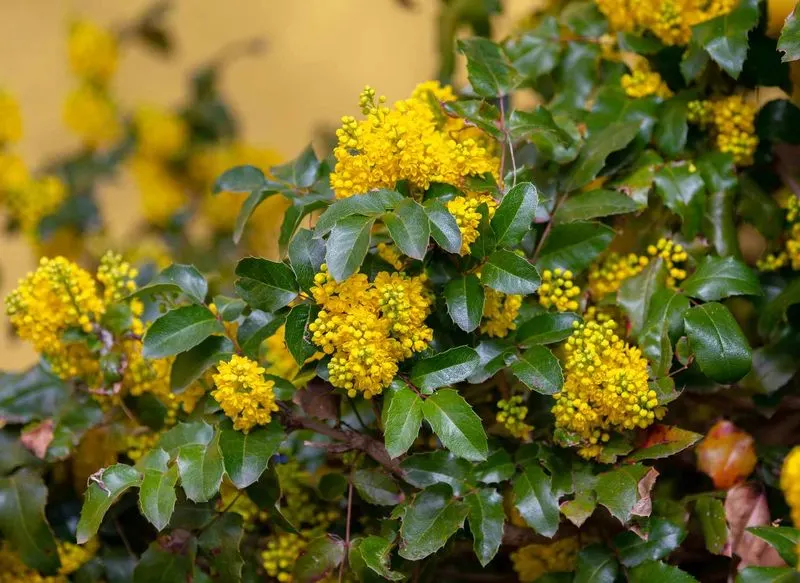
Mahonia plants stand out with their spiky leaves and bright yellow flowers. The evergreen foliage offers a unique texture, while the blooms add seasonal color. These plants thrive in shaded areas with well-drained soil, making them ideal for woodland gardens. Mahonias require minimal care, with occasional pruning to remove old growth. Their berries attract birds, adding another level of biodiversity to your garden. With their distinctive appearance and ecological benefits, mahonias are an excellent choice for gardeners seeking both beauty and function in their plantings.
Oleander
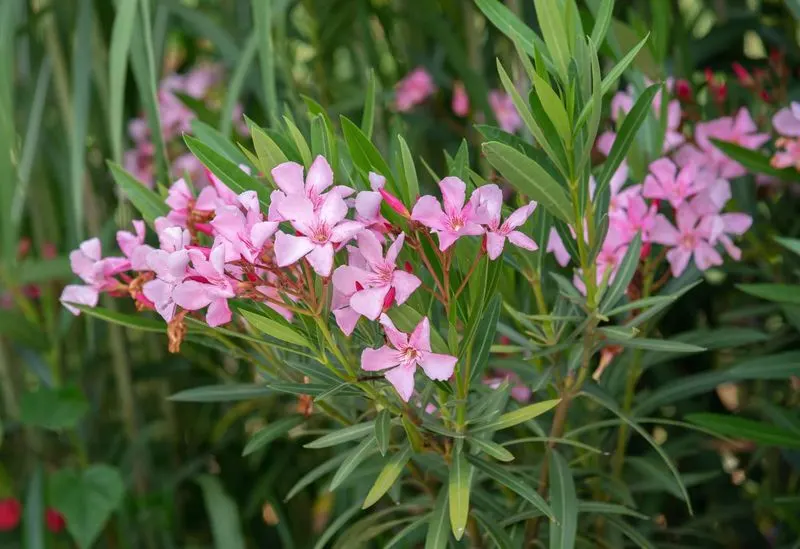
Oleander plants captivate with their vibrant flowers and narrow, evergreen leaves. They are well-suited to sunny, warm climates and require little water once established. Oleanders can serve as striking hedges or standalone specimens, offering both color and privacy. Regular pruning helps maintain their shape and encourages more prolific flowering. Their toxicity means they should be planted with care, especially in gardens accessible to pets or children. Despite this, their resilience and beauty make oleanders a popular choice for those seeking a bold, evergreen presence.
Photinia
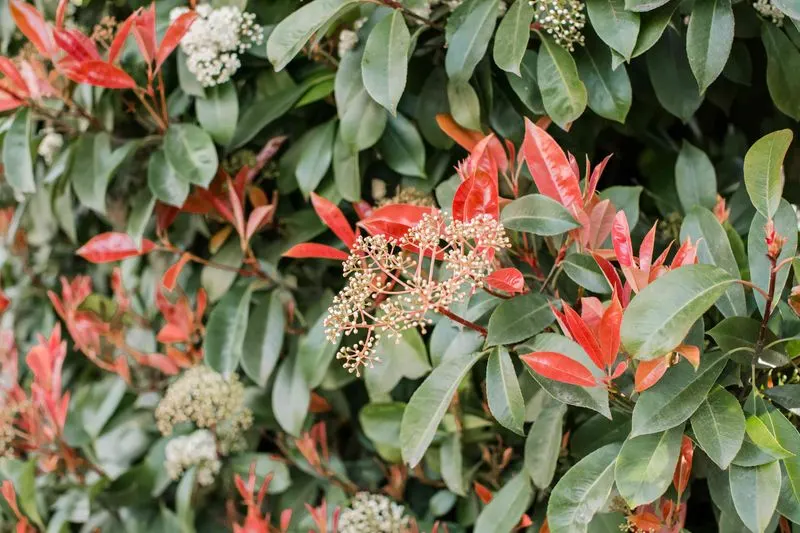
Photinia plants are recognized for their vibrant red-tipped leaves and clusters of white flowers. The evergreen foliage provides constant color, with new growth adding striking contrast. Photinias thrive in sunny locations with well-drained soil, requiring regular pruning to maintain their shape. These plants can be used as hedges or focal points, offering both privacy and visual interest. Their ability to attract pollinators adds ecological value to gardens. With their colorful leaves and seasonal blooms, photinias ensure a lively garden atmosphere throughout the year.
Privet
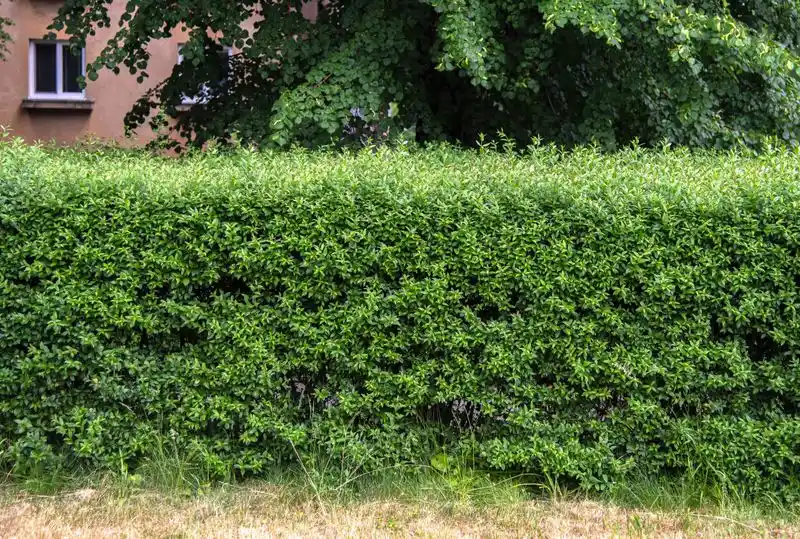
Privet hedges offer a classic look with their small, glossy leaves and white flowers. These evergreens are perfect for creating formal garden boundaries or privacy screens. Privets thrive in a range of soil types and climates, preferring sunny to partially shaded areas. Regular pruning helps maintain their dense growth and shape, ensuring a tidy appearance. Beyond aesthetics, privets provide shelter for wildlife, adding ecological benefits. With their enduring foliage and adaptability, privets are a reliable choice for gardeners seeking structure and year-round greenery.
Rosemary
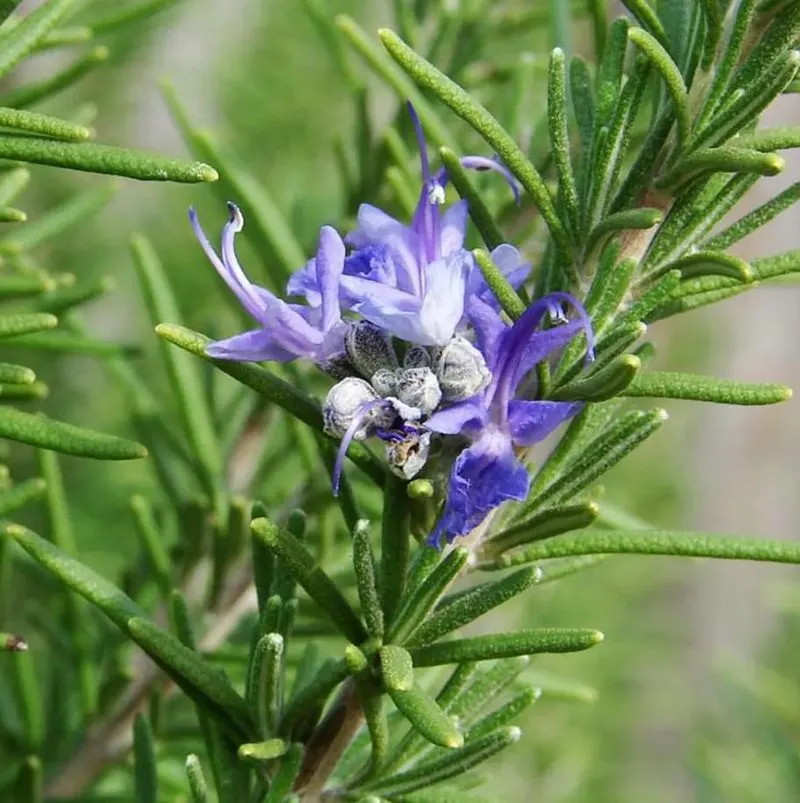
Rosemary combines beauty with utility, offering aromatic leaves often used in cooking. Its needle-like foliage remains vibrant year-round, adding both visual and practical appeal. Rosemary thrives in sunny locations with well-drained soil, making it ideal for herb gardens or borders. Regular pruning encourages denser growth and more prolific flowering. The leaves can be harvested for cooking, providing a fragrant touch to culinary creations. With its evergreen nature and culinary uses, rosemary is a versatile addition to any garden, offering beauty and function.
Yew
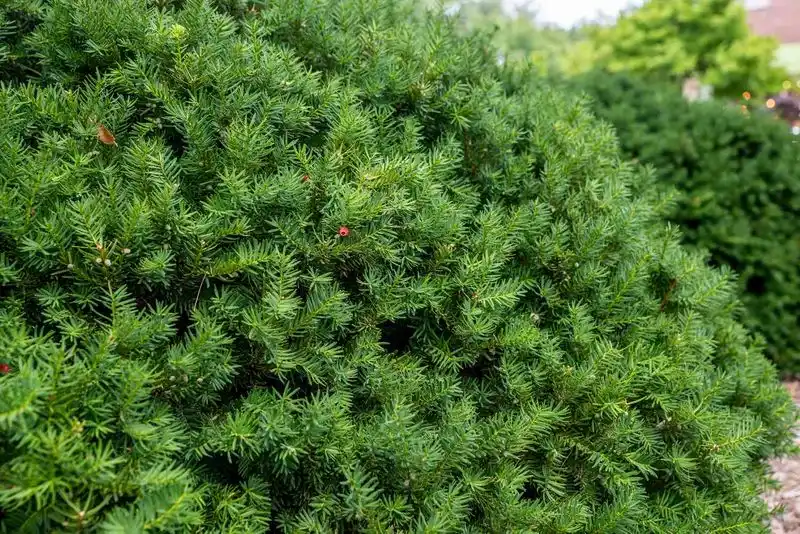
Yews are treasured for their dense, dark green foliage and versatile shaping options. These evergreens thrive in various soil types and can adapt to sun or shade. Yews are often used in formal gardens, shaped into hedges or topiaries. Regular pruning helps maintain their form and encourages healthy growth. Beyond their aesthetic appeal, yews provide habitat for wildlife, enhancing garden biodiversity. Their resilience and classic look make them a favorite among gardeners seeking an evergreen plant that offers both beauty and functionality year-round.
Azalea
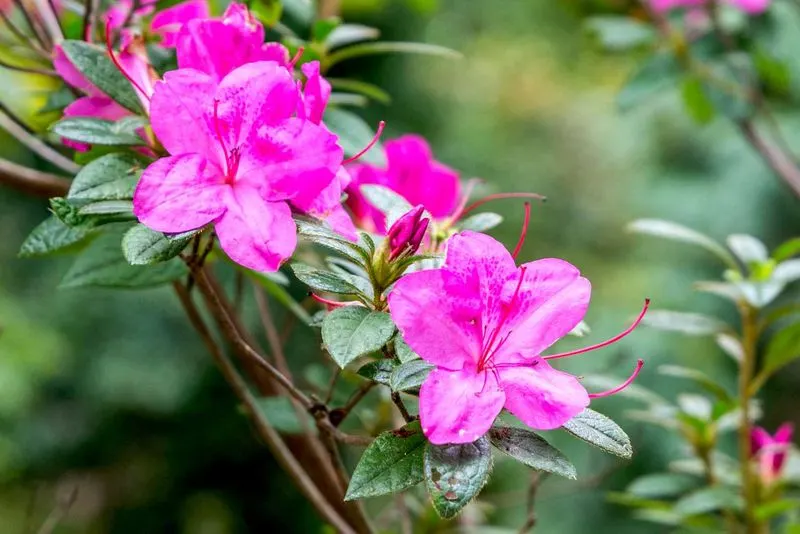
Azaleas are celebrated for their vibrant blooms and glossy evergreen leaves. Although their flowers are seasonal, the foliage provides constant interest. These plants thrive in partial shade with acidic, well-drained soil. Regular watering and mulching enhance their health, while minimal pruning keeps them tidy. Azaleas can be planted as showy specimens or part of a mixed border, adding bursts of color. Their ability to attract pollinators adds ecological value. With their beautiful blooms and enduring leaves, azaleas ensure your garden remains attractive throughout the year.
Magnolia
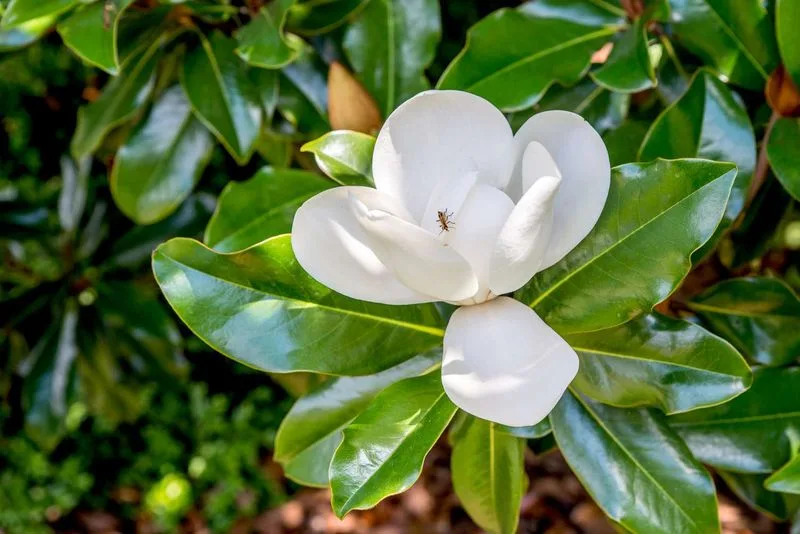
Magnolias offer stunning beauty with their large, fragrant flowers and glossy evergreen leaves. While their blooms are the highlight in spring, the foliage remains appealing year-round. Magnolias prefer sunny to partially shaded locations with well-drained soil. Regular watering and occasional pruning enhance their growth and shape. These trees can serve as focal points or part of a larger landscape design. Beyond aesthetics, magnolias provide habitat for birds and other wildlife. With their magnificent flowers and lasting greenery, magnolias elevate the visual appeal of any garden.
Acacia
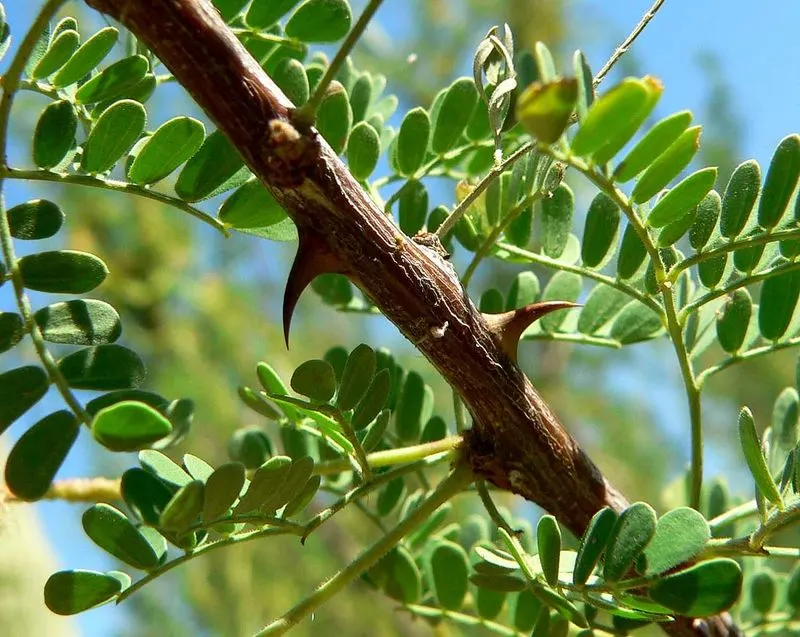
Acacia trees are known for their feathery foliage and bright yellow blooms. Their evergreen nature provides constant beauty, while the flowers offer seasonal interest. Acacias thrive in sunny locations with well-drained soil, making them suitable for drier climates. Their drought-tolerant nature means they require little water once established. These trees can be used as standalone specimens or in groupings for a more dramatic effect. Beyond their visual appeal, acacias support diverse wildlife, enhancing the ecological richness of gardens. With their unique appearance and resilience, acacias are a delightful addition to any landscape.

